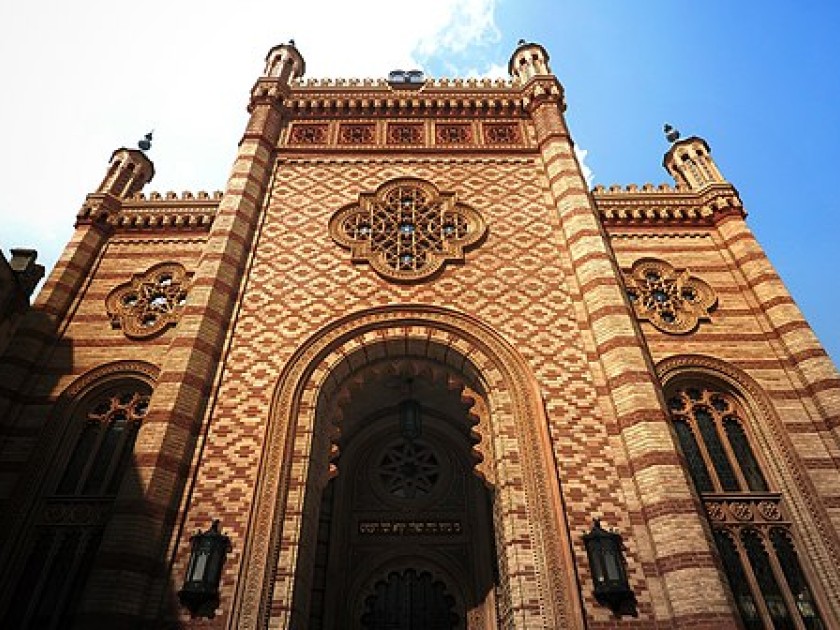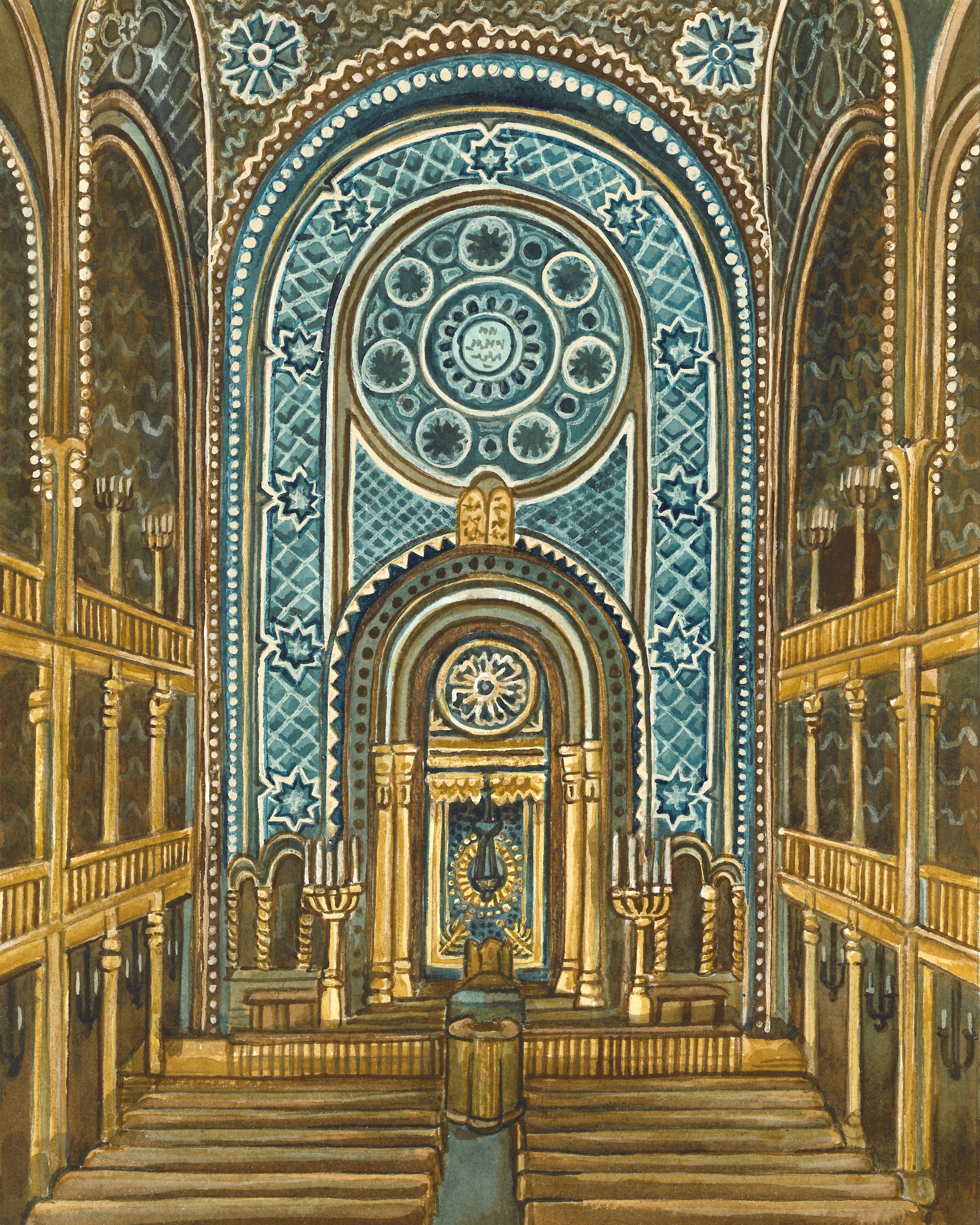
The Choral Temple in Bucharest
Vienna: Leopoldstädter Temple, 1858
Vienna, long the capital of the Holy Roman Empire, became the capital of the newly created Austrian Empire in 1804. After the first World War, as the Empire became the First Republic of Austria, it remained the capital. Vienna briefly became part of Germany, upon the Third Reich’s annexation of Austria in 1938, but once Austria regained its statehood after World War II, Vienna returned to its status as capital.
Jews have been present in Austria for close to two thousand years. In 2008 archeologists uncovered the third-century C.E. grave of an infant in Austria containing an amulet with the Shema prayer (a central element of the Jewish liturgy) inscribed on it.
The first Jews in Austria may have followed the Roman army back from their occupation of Israel as aids, procurers of goods, and merchants to the soldiers. A tenth-century document discussing Jewish and Christian traders suggests that Jews lived in Vienna. The community was established by 1204, when a synagogue was constructed and records show new Jewish residents arriving from Bavaria and the Rhineland.
In July 1244 Duke Frederick II issued a charter that outlined rights for Jews in Vienna and also affected Jewish communities in nearby areas. Jews were barred from many jobs, economic activities, and learning settings but were allowed to make sales, organize commerce, and lend money. The bill promised the monarch’s protection and the community’s right to its own court system and ability to collect taxes. Though it encouraged other Jews to move to the area, over the centuries Jews underwent cycles of harassment, expulsion, and resettlement. In the late 1600s only the first-born Jewish children were allowed to marry, in an attempt to minimize the number of Jewish residents.
Although Leopold I, Holy Roman Emperor and Archduke of Austria (1640−1705), treated the Jewish population severely, his economic advisor was Samson Wertheimer, who also served as chief rabbi of Eisenstadt, Hungary, and Moravia. As an intermediary between the Emperor and the Jewish community, Wertheimer was a Court Jew whose services to the Emperor elevated his status. Ten royal soldiers served as guards at his residence. He owned many palaces and gardens in Vienna and elsewhere and established schools, endowed synagogues, and distributed significant funds in Europe and the Land of Israel. Jews visiting Vienna from outside the city were not allowed to remain overnight without a written permit from Wertheimer.

Artist Andrea Strongwater’s painting of the Leopoldstädter Temple
Starting in 1848, with Franz Joseph I’s reign as Emperor of the Austria-Hungary Empire, the Jewish community of Austria experienced an era of relative prosperity. A new constitution written in 1867 gave Jews full equal rights that included the right to live wherever they wished in Austria and to practice their Judaism freely. The number of Jews residing in Vienna increased from 6,200 in 1860 to 40,200 in 1870 to 185,000 in 1938, with Viennese Jews making contributions in the arts, medicine, banking, and business.
Leopoldstädter Temple, also called Israelitische Bethaus in der Wiener Vorstadt Leopoldstadt, opened in 1858 in the Leopoldstadt district. The largest synagogue in Vienna at the time, it seated 2,200 people with standing room for another 1,500. Architect Ludwig Förster, who was not Jewish but designed other synagogues (most notably the Dohány Street Synagogue in Budapest and the Synagogue of Miskolc, Hungary) as well as churches, designed and built all three synagogues in a Moorish style. His concept was influential and many synagogues would imitate it — some copying exactly the Leopoldstadt’s flat three-part facade and roof, ornamental minarets of symmetrical design, and a basilica layout with balconies. The Choral Temple in Bucharest, the Zagreb Synagogue in Croatia, the Spanish Synagogue in Prague, the Tempel Synagogue in Kraków, and the Grand Synagogue of Edirne are examples.
The synagogue housed an important Jewish library. In August 1917, after a celebration for Emperor Karl I’s birthday organized by young Jewish soldiers, a fire severely damaged the building. The renovations were finished in 1921.
The synagogue was destroyed on Kristallnacht along with all but one of the other twenty-one formal synagogues in Vienna. The synagogue that remained on the Seitenstettengasse had been built between two buildings owned by Christians. Setting it on fire or blowing it up would have damaged the other buildings. It is also possible that the Nazis did not realize it was a synagogue.
A memorial plaque on the site is written in German and Hebrew. Translated into English it reads: “Here stood the Leopoldstädter Temple, built in 1858 in Moorish style to the plans of Leopold Forster, and destroyed down to the foundations on the so-called Night of Broken Glass, 10th November 1938 by National Socialist barbarians.”
Today, Vienna’s approximately 12,000 Jews include Eastern European refugees and their children, Austrian Jews who lived abroad during WWII, and Iranian Jews. The city was also a transit point for Jews leaving the Soviet Union on their way to the U.S. or Israel.
Excerpted with permission from Lost Synagogues of Europe: Paintings and Histories by Andrea Strongwater, The Jewish Publication Society, November 2025. Artist Andrea Strongwater’s painting of the Leopoldstädter Temple appears on the book cover.
Andrea Strongwater is an author and artist whose artwork has been shown worldwide, including in the collections of the University Medical Center of Princeton, the Herbert F. Johnson Museum in Ithaca, New York, the Jewish Theological Seminary in New York, Or Hadash Synagogue in Atlanta, and the Georges Cziffra Foundation in Senlis, France. Some of her paintings have been sold, and their images have also been sold as prints, postcards, and notecards at the United States Holocaust Memorial Museum in Washington, DC, the Shoah Memorial in Paris, and to private collectors. The forerunner to this present volume is her award-winning children’s book Where We Once Gathered: Lost Synagogues of Europe.